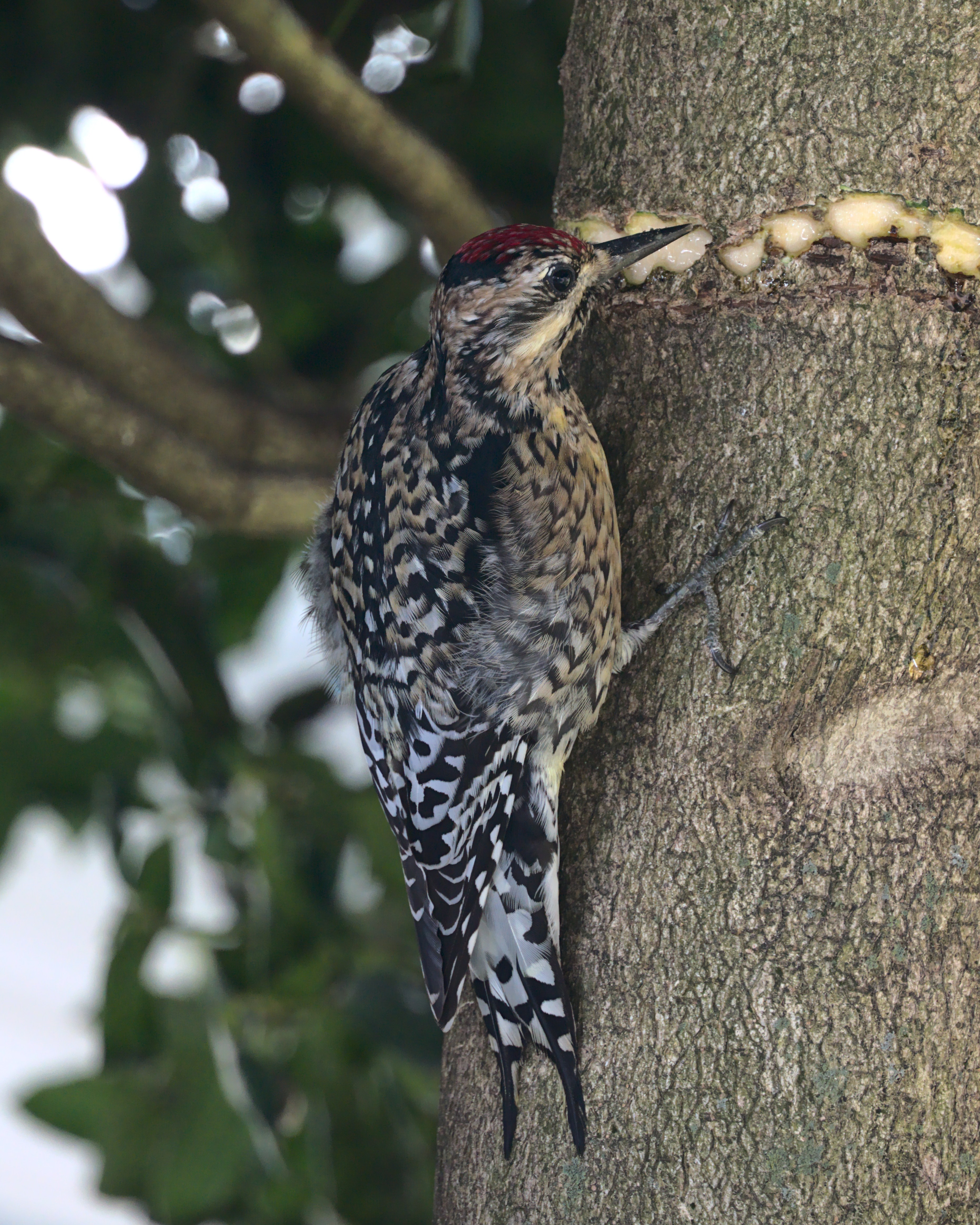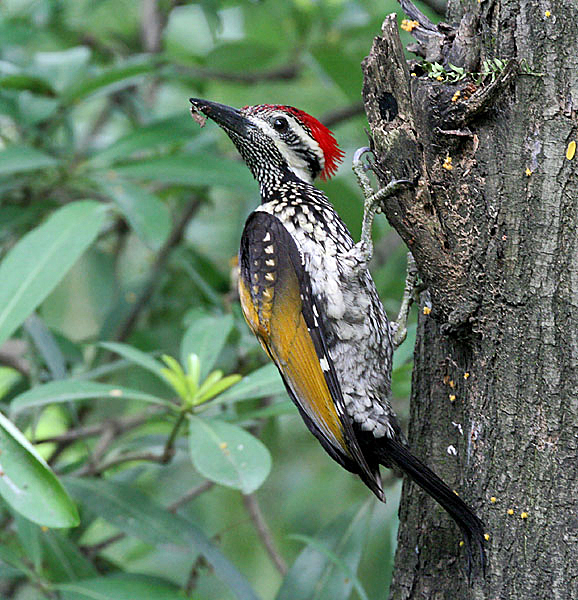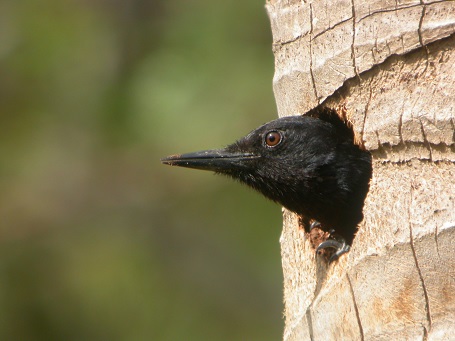|
Sphyrapicus
The sapsuckers are species of North American woodpeckers in the genus ''Sphyrapicus''. Taxonomy and systematics The genus ''Sphyrapicus'' was introduced in 1858 by the American naturalist Spencer Fullerton Baird, Spencer Baird with the yellow-bellied sapsucker (''Sphyrapicus varius'') as the type species. The genus name combines the Ancient Greek ''sphura'' meaning "hammer" and ''pikos'' meaning "woodpecker". The genus is sister taxon, sister to the genus ''Melanerpes''; both genera are members of the Tribe (biology), tribe Melanerpini in the woodpecker subfamily Picinae. There are four currently recognized species in the genus: Description The members of this genus are slender birds with stiff tails and relatively long wings. Their typical pattern in flight is undulating, alternating between quick bursts of wing beats and short dips with wings tucked against the body. Behavior As their name implies, sapsuckers feed primarily on the sap of trees, moving among diffe ... [...More Info...] [...Related Items...] OR: [Wikipedia] [Google] [Baidu] |
Sphyrapicus Varius
The yellow-bellied sapsucker (''Sphyrapicus varius'') is a medium-sized woodpecker that breeds in Canada and the northeastern United States. Taxonomy The yellow-bellied sapsucker was described and illustrated using a hand-coloured plate by the English naturalist Mark Catesby in his ''The Natural History of Carolina, Florida and the Bahama Islands'' which was published between 1729 and 1732. When in 1766 the Swedish naturalist Carl Linnaeus updated his ''Systema Naturae'' for the twelfth edition, he included the yellow-bellied sapsucker, coined the binomial name ''Picus varius'' and cited Catesby's book. The specific epithet ''varius'' is the Latin word meaning "various", "diverse" or "variegated". Linnaeus specified the type locality as ''America septentrionalis'' (North America) but the locality is now restricted to South Carolina. The yellow-bellied sapsucker is now placed in the genus ''Sphyrapicus'' that was erected in 1858 by the American naturalist Spencer Baird with the ... [...More Info...] [...Related Items...] OR: [Wikipedia] [Google] [Baidu] |
Sphyrapicus Nuchalis
The red-naped sapsucker (''Sphyrapicus nuchalis'') is a medium-sized North American woodpecker. Long thought to be a subspecies of the yellow-bellied sapsucker, it is now known to be a distinct species. Systematics The red-naped sapsucker is one of four North American woodpeckers in the genus ''Sphyrapicus''. It has no subspecies. First described by Spencer Fullerton Baird in 1858, it was initially thought to be a subspecies of the yellow-bellied sapsucker. However, there are significant genetic differences between this species and the yellow-bellied sapsucker, and the American Ornithologists' Union recognized it as a distinct species in the seventh edition of its North American birds checklist, published in 1998. Genetic analysis has shown that the red-naped sapsucker is a sister species with (and very closely related to) the red-breasted sapsucker, and that these two species form a superspecies with the yellow-bellied sapsucker. All three species are known to hybridize with each ... [...More Info...] [...Related Items...] OR: [Wikipedia] [Google] [Baidu] |
Sphyrapicus Ruber
The red-breasted sapsucker (''Sphyrapicus ruber'') is a medium-sized woodpecker of the forests of the west coast of North America. Taxonomy The red-breasted sapsucker was formally described in 1788 by the German naturalist Johann Friedrich Gmelin in his revised and expanded edition of Carl Linnaeus's ''Systema Naturae''. He placed it with the woodpeckers in the genus ''Picus'' and coined the binomial name ''Picus ruber''. The specific epithet is Latin meaning "red". Gmelin based his description on the "red-breasted woodpecker" that had been described in 1782 by the English ornithologist John Latham in his ''A General Synopsis of Birds''. Latham mistakenly believed that his specimen had come from Cayenne in French Guiana. The type locality has been designated as Nootka Sound in the Canadian province of British Columbia. The red-breasted sapsucker is now one of four species placed in the genus ''Sphyrapicus'' that was introduced in 1858 by the American naturalist Spencer Baird. ... [...More Info...] [...Related Items...] OR: [Wikipedia] [Google] [Baidu] |
Sphyrapicus Thyroideus
Williamson's sapsucker (''Sphyrapicus thyroideus'') is a medium-sized woodpecker belonging to the genus ''Sphyrapicus'' (sapsuckers). Habitat and range Breeding habitat is open forested areas with conifers, mainly ponderosa pine, douglas-fir, and grand fir. Subalpine fir and western larch may also be important components of good habitat for these birds. Partially migratory, they breed in western North America from northern Mexico as far north as British Columbia. They are permanent residents in some parts of their range; migrating birds form small flocks and may travel as far south as central Mexico. Description Adult males are iridescent black on their head, back, sides and tail. They have a white stripe behind the eye and a lower white stripe across each side of the head, a red chin and a bright yellow belly. They have black wings with large white patches. The female is completely different in appearance: mainly black, with a pale yellow breast, a brownish head with black strea ... [...More Info...] [...Related Items...] OR: [Wikipedia] [Google] [Baidu] |
Birds Of North America
The lists of birds in the light blue box below are divided by biological family. The lists are based on ''The AOS Check-list of North American Birds'' of the American Ornithological Society and ''The Clements Checklist of Birds of the World'' supplemented with checklists from Panama, Greenland, and Bermuda. It includes the birds of Greenland, Canada, the United States (excluding Hawaii), Mexico, Central America, Bermuda, and the West Indies. Taxonomy The taxonomic treatment (designation and sequence of orders, families and species) and nomenclature (common and scientific names) used in the accompanying bird lists adheres to the conventions of the AOS's (2019) ''Check-list of North American Birds'', the recognized scientific authority on the taxonomy and nomenclature of North America birds. The AOS's Committee on Classification and Nomenclature, the body responsible for maintaining and updating the ''Check-list'', "strongly and unanimously continues to endorse the biological spe ... [...More Info...] [...Related Items...] OR: [Wikipedia] [Google] [Baidu] |
Woodpecker
Woodpeckers are part of the bird family (biology), family Picidae, which also includes the piculets, wrynecks and sapsuckers. Members of this family are found worldwide, except for Australia, New Guinea, New Zealand, Madagascar and the extreme polar regions. Most species live in forests or woodland habitats, although a few species are known that live in treeless areas, such as rocky hillsides and deserts, and the Gila woodpecker specializes in exploiting cacti. Members of this family are chiefly known for their characteristic behaviour. They mostly forage for insect prey on the trunks and branches of trees, and often communicate by drumming with their beaks, producing a reverberatory sound that can be heard at some distance. Some species vary their diet with fruits, birds' eggs, small animals, tree sap, human scraps, and carrion. They usually nest and roost in holes that they excavate in tree trunks, and their abandoned holes are of importance to other cavity-nesting birds. They ... [...More Info...] [...Related Items...] OR: [Wikipedia] [Google] [Baidu] |
Picinae
Picinae containing the true woodpeckers is one of four subfamilies that make up the woodpecker family Picidae. True woodpeckers are found over much of the world, but do not occur in Madagascar or Australasia. Woodpeckers gained their English name because of the habit of some species of tapping and pecking noisily on tree trunks with their beaks and heads. This is both a means of communication to signal possession of territory to their rivals, and a method of locating and accessing insect larvae found under the bark or in long winding tunnels in the tree or upright log. Physiology and behaviour Some woodpeckers and wrynecks in the order Piciformes have zygodactyl feet, with two toes pointing forward, and two backward. These feet, though adapted for clinging to a vertical surface, can be used for grasping or perching. Several species have only three toes. The woodpecker's long tongue, in many cases as long as the woodpecker itself, can be darted forward to capture insects. Th ... [...More Info...] [...Related Items...] OR: [Wikipedia] [Google] [Baidu] |
Melanerpes
''Melanerpes'' is a genus of woodpeckers of the family Picidae found in the Americas. The 23 members of the genus are mostly colourful birds, conspicuously barred in black and white, with some red and yellow. Taxonomy The genus ''Melanerpes'' was introduced by the English ornithologist William Swainson in 1832 to accommodate the red-headed woodpecker (''Melanerpes erythrocephalus''). The generic name combines the Ancient Greek ''melas'' meaning "black" with ''herpēs'' meaning "creeper". The genus forms part of the large tribe ''Melanerpini'', which also includes the North American sapsuckers in the genus '' Sphyrapicus'' and the monotypic genus ''Xiphidiopicus'' containing only the Cuban green woodpecker (''Xiphidiopicus percussus''). Characteristics Members of ''Melanerpes'' are small to medium-sized woodpeckers found exclusively in the New World. Some are West Indian endemics, and include species from Hispaniola, Puerto Rico, Jamaica and Guadeloupe; one subspecies, the G ... [...More Info...] [...Related Items...] OR: [Wikipedia] [Google] [Baidu] |
Tree
In botany, a tree is a perennial plant with an elongated stem, or trunk, usually supporting branches and leaves. In some usages, the definition of a tree may be narrower, e.g., including only woody plants with secondary growth, only plants that are usable as lumber, or only plants above a specified height. But wider definitions include taller palms, tree ferns, bananas, and bamboos. Trees are not a monophyletic taxonomic group but consist of a wide variety of plant species that have independently evolved a trunk and branches as a way to tower above other plants to compete for sunlight. The majority of tree species are angiosperms or hardwoods; of the rest, many are gymnosperms or softwoods. Trees tend to be long-lived, some trees reaching several thousand years old. Trees evolved around 400 million years ago, and it is estimated that there are around three trillion mature trees in the world currently. A tree typically has many secondary branches supported cle ... [...More Info...] [...Related Items...] OR: [Wikipedia] [Google] [Baidu] |






